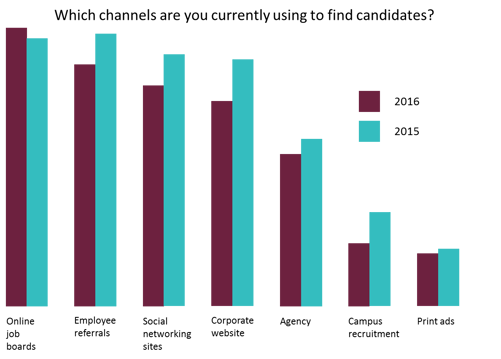Which channels are most companies using to attract talent? And, more importantly, which of those channels are providing them with the best candidates?
Those are among the questions we asked HR professionals from around the globe in our 2016 McQuaig Global Talent Recruitment Survey. Let’s have a look at what the results tell us.
Sourcing
When we look at the channels that companies are using to source talent, there are a couple of interesting changes from last year in terms of the top recruiting channels.

Employee referrals and online job boards switched positions from last year with job boards now the channel used by the most companies to source candidates. Online job boards rose slightly to 82%, while employee referrals dropped seven points to 74%. Overall, it looks like companies were using more channels in 2015 than they are in 2016.
North Americans are the biggest users of social recruiting, with 78% citing this as a channel vs. 69% globally.
The Recruiting Channels Delivering the Best Candidates
There was a big shift in which channel HR professionals said was delivering the highest quality candidates from last year’s survey. Employee referrals remained the top pick, with 33% saying this was where they got their best candidates, but online job boards made a huge jump year-over-year, nearly doubling, to 31%. This result really surprised us so we reached out to a couple of experts to get their insights into what was going on here.
“This does not surprise me,” said Andrew LaCivita, Founder & CEO of Milewalk, an executive search company based in Chicago, IL. “Understand that organizations generally use job boards to fill the lower-level positions. While this is historically true, it’s especially important to note in today’s employment market because employers have made it much more difficult for other organizations to lure away their senior-level talent. We’re seeing this across the positions we recruit.
“Executive search firms and internal corporate recruitment units are therefore having a much tougher time recruiting those specialty skilled and senior positions. So, it stands to reason that, when compared across other recruitment channels, job boards quality – and likely quantity – appears higher.”
Paul Wolfe, SVP of Human Resources at Indeed, an online job site, pointed to a change in job seeker behavior as one possible explanation for the change.
“The strengthened economy means that people are being proactive about job search and are considering new roles more frequently, and job sites are the most efficient and effective way for people to look for new opportunities,” said Wolfe.
“Employers are taking notice of the shifting behaviors and are finding great fits for their roles through job sites and relying less on traditional means like staffing agencies or referrals.”
Indeed’s own research shows that 44% of adults subscribe to job alerts.
How Leadership Impacts Recruiting
Our survey also asked HR professionals to tell us whether or not they felt their leaders were effective or not. When we break out the results along those lines, there are some interesting differences in responses as you can see below.

Their usage is significantly higher in social recruiting than that of the group who rated their leaders less effective. This make sense to us. A big part of social recruiting is about creating awareness of your employer brand and engaging with potential candidates online to build a talent pool. If you have a leader that you can put on a pedestal to present to the world, that makes those things that much easier. More engaged leaders are also more likely to be active in these channels themselves, creating even greater opportunities.
What are your most effective recruiting channels? Let us know in the comments!